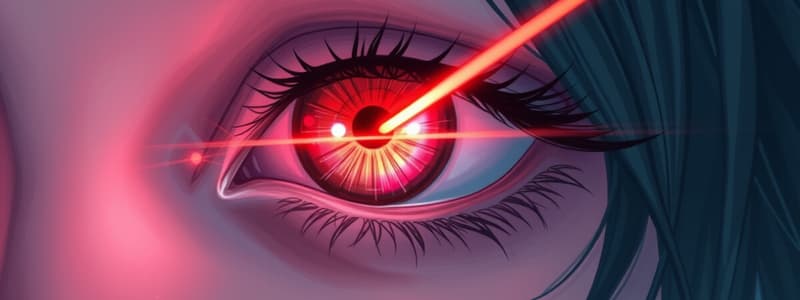Podcast
Questions and Answers
What characterizes latent squint (heterophoria)?
What characterizes latent squint (heterophoria)?
- Eye deviation is apparent without binocular vision.
- Only occurs in individuals over the age of 60.
- It is a permanent condition with visible symptoms.
- The eye remains straight due to binocular vision. (correct)
Which type of phoria involves an outward deviation of the eye?
Which type of phoria involves an outward deviation of the eye?
- Exophoria (correct)
- Hypophoria
- Esophoria
- Hyperphoria
What is the primary purpose of the Cover-Uncover Test?
What is the primary purpose of the Cover-Uncover Test?
- To measure the strength of extraocular muscles.
- To assess the patient’s visual acuity.
- To diagnose the specific type of heterophoria.
- To identify any deviation when binocular vision is disrupted. (correct)
What does the Maddox rod test primarily measure?
What does the Maddox rod test primarily measure?
Which treatment option is typically used as a last resort for heterophoria?
Which treatment option is typically used as a last resort for heterophoria?
How prevalent is heterophoria in the general population?
How prevalent is heterophoria in the general population?
Which of the following is NOT a type of heterophoria?
Which of the following is NOT a type of heterophoria?
In a decompensated case of heterophoria, what condition might manifest?
In a decompensated case of heterophoria, what condition might manifest?
Which extra-ocular muscle primarily facilitates adduction?
Which extra-ocular muscle primarily facilitates adduction?
What primary action is performed by the inferior oblique muscle?
What primary action is performed by the inferior oblique muscle?
According to Sherrington's Law, what happens when the lateral rectus contracts?
According to Sherrington's Law, what happens when the lateral rectus contracts?
Which type of movement is defined as the movement of both eyes in the same direction?
Which type of movement is defined as the movement of both eyes in the same direction?
In the prism-cover test, what is the general formula to determine the angle in degrees?
In the prism-cover test, what is the general formula to determine the angle in degrees?
Which of the following best describes the term 'vergence movement'?
Which of the following best describes the term 'vergence movement'?
What is the primary role of agonist muscles in ocular motility?
What is the primary role of agonist muscles in ocular motility?
If the corneal light reflex is noted to be at the pupil margin, what does this indicate regarding angle of squint?
If the corneal light reflex is noted to be at the pupil margin, what does this indicate regarding angle of squint?
Which of the following is NOT one of the classic symptoms of congenital glaucoma?
Which of the following is NOT one of the classic symptoms of congenital glaucoma?
What is the primary inherited pattern of primary congenital glaucoma?
What is the primary inherited pattern of primary congenital glaucoma?
Which of the following types of congenital glaucoma has the highest prevalence?
Which of the following types of congenital glaucoma has the highest prevalence?
What is a significant sign of congenital glaucoma seen in infancy?
What is a significant sign of congenital glaucoma seen in infancy?
Which of the following statements about secondary congenital glaucoma is true?
Which of the following statements about secondary congenital glaucoma is true?
What is the most common type of glaucoma overall?
What is the most common type of glaucoma overall?
Which of the following is considered an early sign of congenital glaucoma?
Which of the following is considered an early sign of congenital glaucoma?
What percentage of cases of primary congenital glaucoma manifest before the age of 6 months?
What percentage of cases of primary congenital glaucoma manifest before the age of 6 months?
What is a common ocular manifestation associated with rheumatoid arthritis?
What is a common ocular manifestation associated with rheumatoid arthritis?
Which of the following is a complication of Sjögren syndrome?
Which of the following is a complication of Sjögren syndrome?
What typical test is used to diagnose Sjögren syndrome?
What typical test is used to diagnose Sjögren syndrome?
Which demographic is most likely to be affected by sarcoidosis?
Which demographic is most likely to be affected by sarcoidosis?
What is a primary symptom of multiple sclerosis?
What is a primary symptom of multiple sclerosis?
Which autoimmune condition is characterized by dryness of the mouth and eyes?
Which autoimmune condition is characterized by dryness of the mouth and eyes?
Which of the following is NOT a treatment option for sarcoidosis?
Which of the following is NOT a treatment option for sarcoidosis?
Which of the following joints is typically spared in rheumatoid arthritis?
Which of the following joints is typically spared in rheumatoid arthritis?
What is the primary treatment goal for amblyopia?
What is the primary treatment goal for amblyopia?
Which type of strabismus involves a large constant alternating angle of deviation?
Which type of strabismus involves a large constant alternating angle of deviation?
In the basic principles of squint surgery, what does recession imply?
In the basic principles of squint surgery, what does recession imply?
What type of amblyopia develops when one eye is excluded from central cortical activity?
What type of amblyopia develops when one eye is excluded from central cortical activity?
Which of the following is a rule for unilateral squint surgery involving exotropia?
Which of the following is a rule for unilateral squint surgery involving exotropia?
At what age does amblyopia typically not develop beyond?
At what age does amblyopia typically not develop beyond?
What is a characteristic feature of non-refractive exotropia?
What is a characteristic feature of non-refractive exotropia?
Which type of amblyopia occurs in children with lateral uncorrected errors?
Which type of amblyopia occurs in children with lateral uncorrected errors?
What is the duration of occlusion therapy to achieve optimal results for amblyopia?
What is the duration of occlusion therapy to achieve optimal results for amblyopia?
Which type of squint surgery involves bilateral lateral rectus resection?
Which type of squint surgery involves bilateral lateral rectus resection?
Which condition is characterized by inflammation of all layers of the sclera?
Which condition is characterized by inflammation of all layers of the sclera?
What is the most common cause of episcleritis?
What is the most common cause of episcleritis?
Which symptom is NOT commonly associated with scleritis?
Which symptom is NOT commonly associated with scleritis?
What type of episcleritis is most prevalent?
What type of episcleritis is most prevalent?
Which type of staphyloma involves bulging associated with keratitis and corneal perforation?
Which type of staphyloma involves bulging associated with keratitis and corneal perforation?
Which condition is more dangerous and less common than episcleritis?
Which condition is more dangerous and less common than episcleritis?
Which of the following is a treatment option for scleritis?
Which of the following is a treatment option for scleritis?
Which extra-ocular muscle originates at the orbital apex?
Which extra-ocular muscle originates at the orbital apex?
Which of the following best describes the characteristic of chronic uveitis?
Which of the following best describes the characteristic of chronic uveitis?
What symptom is commonly associated with acute anterior uveitis?
What symptom is commonly associated with acute anterior uveitis?
Which of the following is NOT a cause of acute anterior uveitis?
Which of the following is NOT a cause of acute anterior uveitis?
What does the presence of aqueous flare indicate?
What does the presence of aqueous flare indicate?
Which type of uveitis involves both the iris and ciliary body?
Which type of uveitis involves both the iris and ciliary body?
How are keratic precipitates classified based on the type of uveitis?
How are keratic precipitates classified based on the type of uveitis?
Which of the following is an example of a non-infectious cause of uveitis?
Which of the following is an example of a non-infectious cause of uveitis?
What is the typical duration of symptoms in acute uveitis?
What is the typical duration of symptoms in acute uveitis?
Study Notes
Latent Squint (Heterophoria)
- Characterized by a tendency for the eye to deviate due to extraocular muscle (EOM) imbalance while being held straight by binocular vision.
- Occurs in 70-80% of the population, with incidence increasing with age.
- Causes include mild weakness in the EOM or errors of refraction.
Types of Heterophoria
- Exophoria: Tendency for eye to deviate outward.
- Esophoria: Tendency for eye to deviate inward.
- Hyperphoria: Tendency for eye to deviate upwards.
- Hypophoria: Tendency for eye to deviate downwards.
- Excyclophoria: Tendency for eye to roll outward.
- Incyclophoria: Tendency for eye to roll inward.
Symptoms
- Most cases are compensated, showing no symptoms.
- Decompensated cases might show manifest squint.
Diagnosis
- Cover-Uncover Test: Assessing eye for deviation by covering one eye to disrupt binocular vision.
- Maddox Rod Test (Far): Evaluates how a red line appears when an eye is covered; deviation indicates heterophoria strength.
- Maddox Wing Test (Near): Assesses vertical and horizontal phoria at a distance of 40 cm using prismatic lenses.
Treatment
- Minor errors may require no treatment.
- Correct refractive errors.
- Consider strengthening weak eye muscles; surgery is a last resort.
Paralytic Squint
- Occurs due to paralysis of one or more extraocular muscles, can be partial (paresis) or complete.
Functions of Extra-Ocular Muscles
- Horizontal Muscles: Lateral rectus (abduction), medial rectus (adduction).
- Vertical Muscles: Superior rectus (elevation), inferior rectus (depression), superior oblique (intorsion), inferior oblique (extorsion).
Ocular Motility Terms
- Ductions: Monocular movements controlled by agonist and antagonist muscles.
- Adduction: Movement in one direction.
- Abduction: Movement in the opposite direction.
- Version Movement: Simultaneous movement of both eyes in the same direction.
- Vergence Movement: Coordinated eye movement, includes convergence (inward) and divergence (outward).
Sherrington's Law
- States that when one muscle contracts (agonist), the antagonist relaxes simultaneously.
Angle of Squint Measurement
- Corneal Light Reflex (Hirschberg Test): Uses light reflection to assess squint angle.
- Prism-Cover Test: Measures angle deviation by determining how much a prism affects the squinting eye.
Inflammation of the Sclera
- Episcleritis: Inflammation of superficial sclera, more common, usually unilateral, associated with collagen diseases.
- Scleritis: Inflammation of all scleral layers, can be bilateral, often seen in elderly females.
Symptoms of Scleral Inflammation
- Episcleritis: Painful not tender, presents with a red eye.
- Scleritis: Painful and tender, red eye, may lead to complications like glaucoma and keratitis.
Staphyloma
- Bulging of sclera or cornea due to conditions such as keratitis or high intraocular pressure.
- Types include anterior (corneal) and posterior staphyloma.
Amblyopia
- Defined as decreased visual acuity without correctable pathology.
- Develops during critical visual development, primarily in children under 6 years of age.
Treatment of Amblyopia
- Occlusion therapy to encourage usage of the amblyopic eye.
Congenital Glaucoma (Buphthalmos)
- Caused by developmental anomalies in the anterior chamber angle, it usually manifests during the first 6 months of life.
- Symptoms include lacrimation and photophobia; signs include large globe, corneal edema, and increased intraocular pressure.
Strabismus
- Types include refractive and non-refractive exotropia, often corrected surgically.
- Can occur due to various underlying diseases.
Autoimmune Diseases
- Sjögren Syndrome: Autoimmune condition affecting lacrimal and salivary glands, presenting with dry mouth and eyes.
- Rheumatoid Arthritis: Autoimmune disease causing symmetrical joint inflammation with ocular manifestations like scleritis and secondary Sjögren syndrome.
- Sarcoidosis: Granulomatous inflammation affecting the eye, can lead to various uveitis types.
Multiple Sclerosis
- Demyelinating disease with ocular features like optic neuritis.
- Typically presents in the 3rd-4th decades of life.
Uveitis
- Inflammation of the uveal tract; classified anatomically, clinically, and etiologically.
- Acute anterior uveitis is common, caused by infections and autoimmune disorders, causing rapid painful loss of vision and photophobia.
Studying That Suits You
Use AI to generate personalized quizzes and flashcards to suit your learning preferences.
Description
Explore the condition of latent squint, or heterophoria, in this quiz. Understand its epidemiology, causes, and different types, including exophoria, esophoria, and hyperphoria. Test your knowledge on how this common eye condition affects the population.




